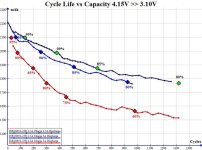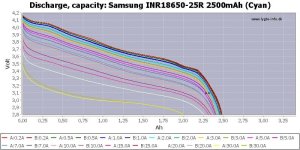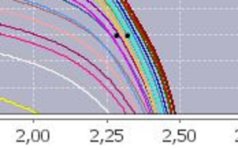DrkAngel
1 GW
29E requested cycle test parameters?
Discharge graph shows optimal static voltages between ~4.10V >> 3.20V
Spec sheets list various charge\discharge rates
This Samsung pdf
lists as 1375mAh (.5C) charge\2750mAh (1C) discharge
Max 2750mAh (1C) charge\2750mAh (1C) discharge 8750mAh (3C) surge
Discharge graph shows optimal static voltages between ~4.10V >> 3.20V
Spec sheets list various charge\discharge rates
This Samsung pdf
lists as 1375mAh (.5C) charge\2750mAh (1C) discharge
Max 2750mAh (1C) charge\2750mAh (1C) discharge 8750mAh (3C) surge




